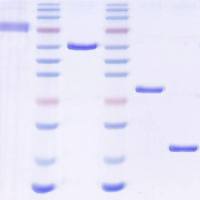Amplified Fragment Length Polymorphism (AFLP)
互联网
The AFLP (Amplified Fragment Length Polymorphism) technique is used to visualize hundreds of amplified DNA bands of restriction fragments simultaneously (Vos et al ., 1995). The AFLP band patterns, or fingerprints, can be used for many purposes, such as monitoring the identity of an individual/population or the degree of similarity among individuals/populations. Polymorphisms in band patterns map to specific loci, allowing the individuals to be genotyped or differentiated based on the alleles they carry. This technique combines the power of restriction fragment length polymorphism (RFLP) with the flexibility of PCR-based technology by ligating primer-recognition sequences (adaptors) to the restricted DNA.
Protocol (Using AFLP Analysis Kit I- Life technologies)
5x reaction buffer 2.5µl ` Sample DNA (25ng) 5µl EcoRI/MseI 1µl Distilled water 4µl Total volume 12.5µlAdd the following to a 1.5ml microcentrifuge tube
Mix gently and collect the reaction by brief centrifugation. Incubate the mixture for 2 hours at 37º C.
Incubate the mixture for 15 minutes at 70º C to inactivate the restriction endonucleases. Place tube on ice and collect contents by brief centrifugation.
Ligation of adapters
Add the following to the digested DNA from step 3 of Section 5.1
Adapter ligation solution 12 µl
T4 DNA ligase 0.5 µl
Mix gently at room temperature, centrifuge briefly to collect contents, and
incubate at 20°C ± 2°C for 2 h.
Perform 110 dilution of the ligation mixture as follows
a. Take 1 µl of the reaction mixture and transfer to a 1.5-ml microcentrifuge
tube.
b. Add 9 µl TE buffer and mix well.
The unused portion of the reaction mixture may be stored at â









